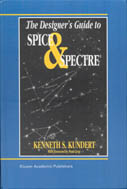

Kenneth S. Kundert, 1995
The Designer's Guide to SPICE and Spectre is not an introduction to circuit simulators. Rather, it assumes that you are already adept at the mechanics of operating a simulator and are interested in understanding how it works and increasing the skill and sophistication with which you use it.
This book is intended to be a practical guide for circuit designers that routinely use circuit simulators. Problems that commonly occur are described with enough depth for you to understand why they occur, and then suggestions are given on how to avoid these problems. These issues are examined in the context of the circuit simulators SPICE-2 and SPICE-3, because the majority of commercial simulators are derivatives of these two programs, and Spectre, currently the most popular circuit simulator for integrated circuit design. Even though these three simulators are the focus of this book, it should be useful to the user of any circuit simulator.
Chapter 1 introduces circuit simulation, both from a historical and a computational perspective. Chapter 2 presents DC analysis and discusses the issue of convergence in depth. Convergence is important for both DC and transient analysis. Chapter 3 covers the small signals analyses, such as AC and noise analysis. Chapter 4 discusses transient analysis, with considerable attention being paid to the issue of accuracy. Chapter 5 talks about Fourier analysis. Finally in Appendix A the various simulator options are described.
The structure of each of the chapters on simulator analyses is similar. They start with an introduction, then delve into the theory or mathematical underpinnings of the analysis. Enough theory is given for you to understand the basic operation of the analysis as well as its characteristics. Examples given in this section illustrate issues that result directly from the underlying mathematics. After the theory, the practical details or heuristics of the implementation are presented. Again, the focus is on presenting those details that directly result in accuracy or convergence issues. Examples given in this section illustrate the issues that result from the heuristics present in simulators. Finally, the chapter finishes up with a presentation of some of the various ways in which the analysis can be used. The intention is to present real-world nontrivial applications that illustrate how to make important measurements or how to resolve some thorny issues.
ISBN 0-7923-9571-9
Library of Congress Call Number TK7867 .K79 1995